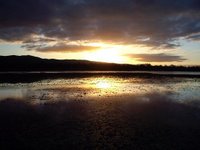Officespace
The Mareeba Wetlands Reserve is a stunningly peaceful place. The visitor centre, where I live, is at the end of ten kilometres of dirt road. The nearest town is Mareeba and with one main street it's only consolation to cosmopolitan life is a Coles and a KFC. The annual Mareeba Rodeo however is apparently impressive and features high on the Australian rodeo circuit (and that's the first I'd heard of the Australian rodeo circuit too).
Tim and Lisa, the resident wardens, live in a small room in the back of the visitor centre. We all share a common living room, which has mains power supply, hot water and even a little television with a bent antenna to keep us in touch with the outside world (though it's difficult to keep track of which muslim country we're bombing). The volunteer accommodation however, is a five minute walk away, down a small bush track. There's no power or hot water for us but it's comfortable enough and I'm instantly at home.
 I'm the only volunteer for the first two weeks and each night after dinner I wander off to my tent with my lamp barely outshining the thousands of scattered stars. kangaroos, wallabies and quolls are common enough in the reserve and in my first few nights these scare the shit out of me as they come leaping out of the nearby bushes as I pass. I'm soon well adjusted however, and the night-noises of grazing roos and hooting owls only helps to lull me to sleep.
I'm the only volunteer for the first two weeks and each night after dinner I wander off to my tent with my lamp barely outshining the thousands of scattered stars. kangaroos, wallabies and quolls are common enough in the reserve and in my first few nights these scare the shit out of me as they come leaping out of the nearby bushes as I pass. I'm soon well adjusted however, and the night-noises of grazing roos and hooting owls only helps to lull me to sleep.Most of the visitors to the wetlands are bird-nerds. They wear khaki and carry their own binoculars. They have field guides describing birds in the minutest of details and they brandish these about like bibles. Many tick off the birds they see in their guides. Tim and Lisa are trained biologists and they can tell a green-pygmy goose from a wondering whistling duck from two hundred meters away.
I know nothing about birds when arrive (though I did manage to pick out a pelican) but Tim and Lisa give me a brief rundown. Before long I can bullshit my way through most of the waterbirds at least. This gets easier once I realise that bird-nerds want to tell you facts they know rather than be told anything; a couple of vague, open questions, some nodding and they will walk away thinking you're a bird expert.
Surprisingly the wetlands are man-made. The original plan was to use them as an irrigation system for lower farming lands. After putting in two of the eight walls, the government then realised that the land they'd targeted for farming was too saline and would be barren within twenty years of farming (brilliant planning!). They abandoned the idea but the two lagoons began to attract waterbirds that had not been seen in the area for years, since natural wetlands had long been drained for farming.
The locals, particularly a couple by the names of Gwyneth and Tim (a different Tim to the warden) who now run the management commitee, saw the potential the place had as a nature reserve. They annoyed the government enough and finally got their way. The lagoons were finished and the wetlands were turned into a wildlife sanctuary and handed over to a not-for-profit, community-run conservancy. This all happened only in the last ten years, so the reserve is still very new and raw. The surrounding land was heavily grazed for the last hundred years and non-native weeds are rampant There's a lot of work to be done and most of the projects are only just getting started.
 With little government funding, the reserve uses tourism to survive. The wardens take turns doing guided boat tours around the lagoon, pointing out birds. Each night we also run a twilight safari. Small groups are taken out in a mini-van through the heart of the reserve to the largest lagoon. There we cook them a billy tea and point out more birds. After that we take them back to the deck to enjoy the spectacular sunset with a glass of wine and fancy cheese. It’s definitely a more pleasant working environment than the ones I typically have.
With little government funding, the reserve uses tourism to survive. The wardens take turns doing guided boat tours around the lagoon, pointing out birds. Each night we also run a twilight safari. Small groups are taken out in a mini-van through the heart of the reserve to the largest lagoon. There we cook them a billy tea and point out more birds. After that we take them back to the deck to enjoy the spectacular sunset with a glass of wine and fancy cheese. It’s definitely a more pleasant working environment than the ones I typically have.

0 Comments:
Post a Comment
<< Home